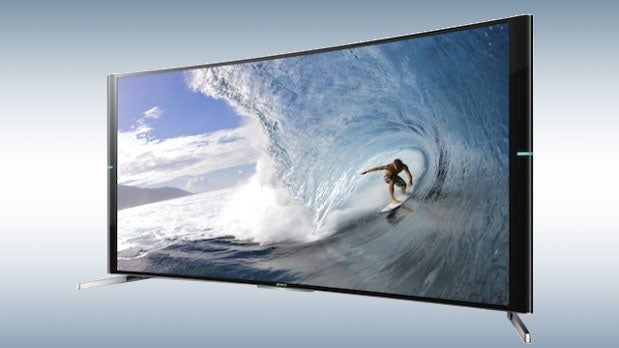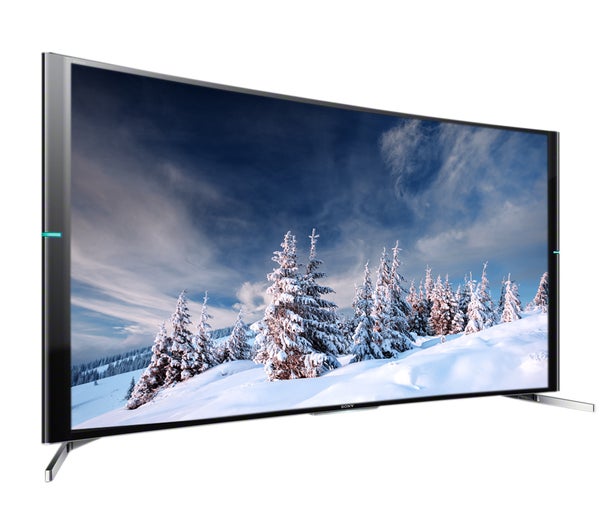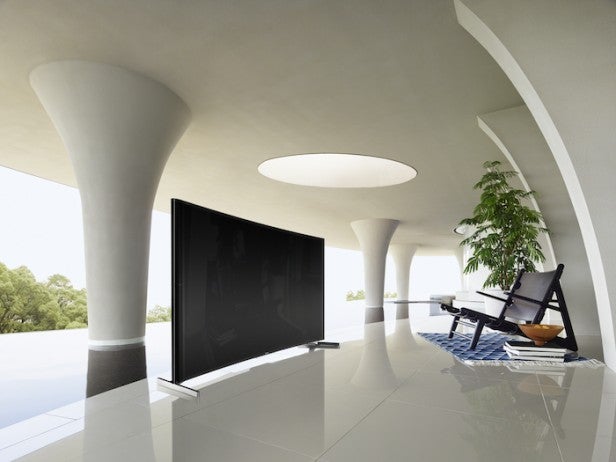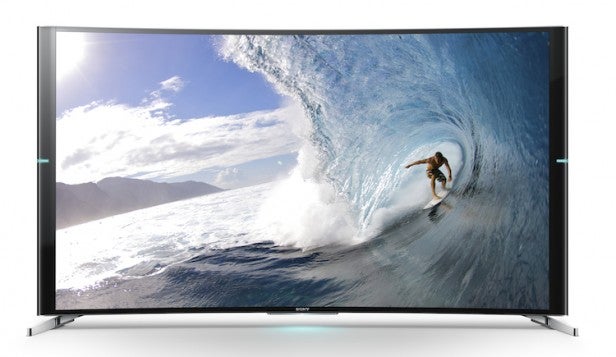Sony KD-65S9005B Review - Picture Quality Review
Picture Quality
Is Sony's first curved TV a case of form over function?

Sections
- Page 1 Sony KD-65S9005B Review
- Page 2 Picture Quality Review
- Page 3 3D, Sound and Conclusions Review
Sony KD-65S9005B – Picture Quality
Since it hit us in the face as soon as we started watching films, let’s get the bad news about the 65S9005B’s pictures out of the way first: there’s prominent backlight clouding. Using the TV’s presets – even the Cinema 1 or 2 ones the TV chooses when it recognises movie content – you’ll find that dark scenes appear behind a number of patches of grey clouding, especially (though not exclusively) in the screen’s corners.
Needless to say this can be seriously distracting, drawing attention away from the video you’re supposed to be focused on. 
Cue the backlight adjustments suggested in the Setup section, which remove most traces of the clouding. Obviously in doing this you’ve taken a chunk of brightness out of the image, but this isn’t too big a deal, as the set’s Triluminos system helps colours retain plenty of punch even without much luminance behind them. The set’s native black-level response is good enough to ensure you can still see plenty of shadow detail in the darkest areas of the picture.
We’d also argue that the 65S9005B’s dark colours look their best when the backlight is reduced to a point where the clouding issues have been removed – not least because there’s no longer an infusion of greyness in everything.
In fact, once the backlight clouding has been sorted, the 65S9005B’s pictures look mostly superb. Native UHD sources look every bit as stunning as they do on Sony’s superb X9005B series, especially as Triluminos is on hand to eke out the 4K subtleties of colour tone that other TVs struggle to reach.
The intense clarity and detailing remains more or less intact when there’s motion in the frame, too, thanks to the X-Reality system’s exceptionally intelligent motion processing.
SEE ALSO: Best Blu-ray Players Round-up

We’ve noted before that 4K TVs can improve the sense of depth in native 4K images, thanks to the way the extra detail allows horizons and distant objects to retain clarity further before they flatten out. This is true of the 65S9005B, too, but the effect is actually exaggerated slightly by the screen’s gentle curve. Partly because the picture’s centre sits physically further back than its edges, which fools your eye into perceiving more depth, and partly because the edges of the image feel marginally more like they’re in your peripheral vision than they do with a normal flat TV.
We’ll talk more about the 65S9005B’s curved screen later, but for now let’s stick with the 65S9005B’s 4K-related picture elements. We’ve already ascertained that native 4K content looks stunning on this Sony, but what about upscaled HD and standard-definition content?
Here again the 65S9005B is exceptional. Its upscaling engine does a terrific job of adding the huge amount of extra pixels required to remap non-4K sources to the screen’s 3840 x 2160 pixel count, adding palpable detail and image density without causing noise, motion blur, stressy edges or exaggerated jaggedness around bright, curved objects.
Sony’s upscaled pictures don’t look quite as ultra-sharp as those of some rivals – especially Samsung. But the marginally gentler approach of Sony’s upscaling is arguably more natural looking, especially with relatively grainy movie content. It should be clarified, too, that sharpness isn’t the same thing as detail, and when it comes to detail Sony’s upscaled images aren’t bettered by any rival.
The 65S9005B’s upscaling is inevitably far more effective with HD sources than standard-definition ones, as even the cleverness of the X-Reality Pro engine can’t stop upscaled standard-def broadcasts from looking a little noisy and soft. The Sony actually still does a better job of retaining colour accuracy and richness with upscaled standard def than we usually see, but the bottom line here is that really, if you’re going to spend the best part of four grand on a 4K TV and then feed it lots of standard-definition pictures, you clearly have more money than sense.
Turning to other aspects of the 65S9005B’s pictures, it’s great after calibrating the TV to find black colours looking genuinely black rather than milky or misty. There’s no sign of the blue or green ‘glow’ you get with some LCD TVs either, and once you’ve got rid of the initial backlight clouding flaws there are precious few distractions from light ‘block’ artefacts caused by the local dimming system. This latter strength stands in stark contrast to the overt light-blocking problems found on TVs using screens with a poor native contrast, and underlines the fact that the 65S9005B’s native contrast is strong.
The strengths of Sony’s Triluminos colour system are abundantly obvious, too. Colours explode off the screen with a vibrancy, punch and extreme range you just don’t get with normal LCD TVs. Also, colour saturation is retained during dark scenes in a way LCD technology usually struggles with, and the extra colour range is more consistently natural and balanced than it was with last year’s Sony X9005A 4K TVs.
Let’s conclude this section by considering how much of an impact the 65S9005B’s curved screen has on pictures. And the short answer is: not that much.
As noted already, the curve does slightly enhance the image’s sense of depth. But it doesn’t do so quite as strongly as Samsung’s curved TVs, with their more extreme curvature.
The reduced curvature also limits the immersive effect created by a sense of the image entering your peripheral vision versus Samsung’s sets, unless you’re sat extremely close to Sony’s screen.
However, Sony’s subtler curve also suffers less – hardly at all, in fact – from the ‘sagging’ look to the edges of the picture that more severely curved TVs exhibit. You can also watch the 65S9005B from a wider angle than more severely curved screens without feeling that the curve is significantly disturbing the image’s geometry. And best of all, the Sony’s gentler curve – combined, perhaps, with better screen filtering – greatly reduces the distorted and stretched onscreen reflections that are so distracting on Samsung and LG’s (OLED) curved offerings.
To sum all this up, the 65S9005B gives you a slightly watered-down experience of the advantages of curved TVs, but also suffers far less with curved TVs’ usual disadvantages.
How we test televisions
We test every TV we review thoroughly over an extended period of time. We use industry standard tests to compare features properly. We’ll always tell you what we find. We never, ever, accept money to review a product.

